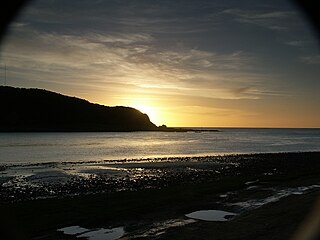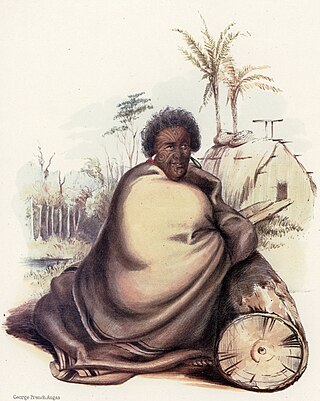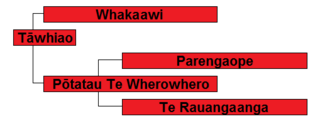
Tainui is a tribal waka confederation of New Zealand Māori iwi. The Tainui confederation comprises four principal related Māori iwi of the central North Island of New Zealand: Hauraki, Ngāti Maniapoto, Ngāti Raukawa, Ngāti Hikairo and Waikato. There are other Tainui iwi whose tribal areas lay outside the traditional Tainui boundaries – Ngāi Tai in the Auckland area, Ngāti Raukawa ki Te Tonga and Ngāti Toa in the Horowhenua, Kāpiti region, and Ngāti Rārua and Ngāti Koata in the northern South Island.

Ngāti Toa, also called Ngāti Toarangatira or Ngāti Toa Rangatira, is a Māori iwi (tribe) based in the southern North Island and the northern South Island of New Zealand. Ngāti Toa remains a small iwi with a population of about 9,000. The iwi is centred around Porirua, Plimmerton, Kāpiti, Blenheim and Arapaoa Island. It has four marae: Takapūwāhia and Hongoeka in Porirua City, and Whakatū and Wairau in the South Island. Ngāti Toa's governing body has the name Te Rūnanga o Toa Rangatira.

Ngāti Maniapoto is an iwi (tribe) based in the Waikato-Waitomo region of New Zealand's North Island. It is part of the Tainui confederation, the members of which trace their whakapapa (genealogy) back to people who arrived in New Zealand on the waka (canoe) Tainui. The 2018 New Zealand census reports show an estimated population of 45,930 people who affiliated with Maniapoto, making it the 9th most-populous iwi in New Zealand.

Pōtatau Te Wherowhero was a Māori rangatira who reigned as the inaugural Māori King from 1858 until his death. A powerful nobleman and a leader of the Waikato iwi of the Tainui confederation, he was the founder of the Te Wherowhero royal dynasty. His 1858 coronation followed years of efforts to create the Kīngitanga, a Māori monarchy intended as an equivalent of the British monarchy, and to foster Māori nationalism against settler encroachment.
Waikato Tainui, Waikato or Tainui is a group of Māori iwi based in Waikato Region, in the western central region of New Zealand's North Island. It is part of the larger Tainui confederation of Polynesian settlers who arrived to New Zealand on the Tainui waka. The tribe is named after the Waikato River, which plays a large part in its history and culture.

Te Rauangaanga was the chief of the Ngāti Mahuta tribe of the Waikato tribal confederation and the principal war chief of the confederation in the late 18th and early 19th centuries. His son Pōtatau Te Wherowhero became the first Maori king.

Rewi Manga Maniapoto (1807–1894) was a Ngāti Maniapoto chief who led Kīngitanga forces during the New Zealand government Invasion of Waikato during the New Zealand Wars.

Ngāti Hauā is a Māori iwi of the eastern Waikato of New Zealand. It is part of the Tainui confederation. Its traditional area includes Matamata, Cambridge, Maungakawa, the Horotiu district along the Waikato River and the Maungatautari district, and its eastern boundary is the Kaimai Range. Leaders of the tribe have included Te Waharoa, his son Wiremu Tamihana and Tamihana's son Tupu Taingakawa. The tribe has played a prominent role in the Māori King Movement, with Tamihana and descendants being known as the "Kingmakers".
Maniapoto was a Māori rangatira (chieftain) of Ngāti Raukawa in the Tainui tribal confederation from the Waikato region, New Zealand, and the founding ancestor of the Ngāti Maniapoto iwi.
Ngāti Te Wehi is a Māori iwi (tribe) based in Kawhia on the west coast of New Zealand's North Island.
This timeline sets out intertribal battles involving Māori people in what is now New Zealand.
Rereahu was a Māori rangatira (chieftain) of Ngāti Raukawa in the Tainui tribal confederation from the Waikato region, New Zealand. He probably lived in the first half of the seventeenth century. He is the ancestor of the Ngāti Maniapoto, Ngāti Hauā, and Ngāti Korokī Kahukura iwi, and of Rereahu, a group based around Maniaiti / Benneydale, Pureora, and Maraeroa in Waitomo District, whose status as a separate iwi or as a hapū (sub-tribe) of Ngāti Maniapoto is a matter of dispute.

Tāmaki Māori are Māori iwi and hapū who have a strong connection to Tāmaki Makaurau, and whose rohe was traditionally within the region. Among Ngā Mana Whenua o Tāmaki Makaurau, also known as the Tāmaki Collective, there are thirteen iwi and hapū, organised into three rōpū (collectives), however Tāmaki Māori can also refer to subtribes and historical iwi not included in this list.
Kinohaku was a Māori woman of the Ngāti Maniapoto tribe in New Zealand's Waikato region. She lived in the seventeenth century and is the eponymous ancestor of the Ngāti Kinohaku sub-tribe (hapū) of Ngāti Maniapoto.
Matakore was a Māori rangatira (chieftain) of Ngāti Maniapoto in the Tainui tribal confederation from the Waikato region, New Zealand. He is an ancestor of the Ngāti Matakore hapū (sub-tribe) of Ngāti Maniapoto and of the southern branch of Ngāti Raukawa. He probably lived in the early seventeenth century.

Te Waiohua or Te Wai-o-Hua is a Māori iwi (tribe) confederation that thrived in the early 17th century. The rohe was primarily the central Tāmaki Makaurau area and they had pā at Te Tātua a Riukiuta, Puketāpapa, Te Ahi-kā-a-Rakataura, Maungakiekie, Maungawhau, Tītīkōpuke, Ōhinerau, Rangitotoiti, Taurarua, Rarotonga, Ōtāhuhu, Te Pane o Mataaoho, Ihumātao, Matukutūreia and Matukutūruru, until the 1740s, when the paramount Waiohua chief, Kiwi Tāmaki, was defeated by the Ngāti Whātua hapū, Te Taoū. The descendants of the Waiohua confederation today include Ngāti Te Ata Waiohua, Ngāti Tamaoho and Te Ākitai Waiohua.
The Ngāti Raukawa–Ngāti Kahu-pungapunga War was a conflict between the Ngāti Raukawa iwi of Tainui and Ngāti Kahu-pungapunga in the Waikato region of New Zealand in the mid-seventeenth century, which resulted in Tainui's acquisition of the upper Waikato River. This marked the final destruction of all non-Tainui people within the Waikato region.
Wairangi was a Māori rangatira (chieftain) of the Ngāti Takihiku hapū of the Ngāti Raukawa iwi in the Tainui tribal confederation from the Waikato region, New Zealand and the ancestor of the Ngāti Wairangi hapū. He probably lived in the mid-seventeenth century.
Tū-te-tawhā Whare-oneone was a 17th-century Māori rangatira (chieftain) of Ngāti Tūwharetoa from the region around Lake Taupō, New Zealand. He arranged a raid in revenge for the murder of his maternal grandfather, Te Ata-inutai. He was a brave warrior, but also excessively proud and died when he led an ambitious but ill-conceived raid up the Waikato River to Cambridge. He probably lived in the mid-seventeenth century. He is the ancestor of the Ngāti Tutetawhā hapu of Ngāti Tūwharetoa.
Pikauterangi was a New Zealand Māori tribal leader. He was the paramount chief of Ngāti Toa in the late 18th or early 19th century. He led Ngāti Toa into battle and defeat, beginning their exodus south.









